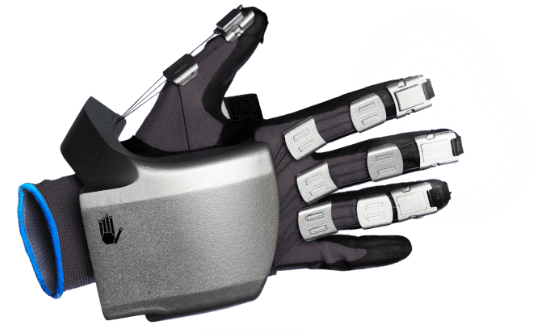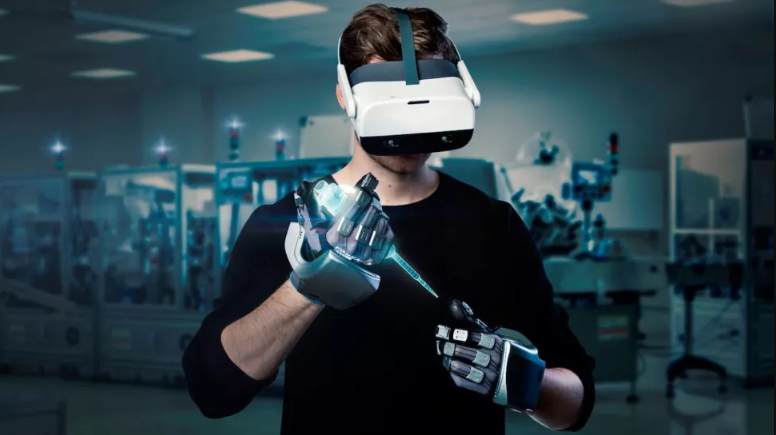Latest Haptics: Feel the Metaverse with SenseGlove Nova Haptic Gloves
Haptic devices are now a dime a dozen and while the technology is constantly undergoing evolution and refinement for a convincing immersive and haptic experience, a number of these innovations have already been productized and are being put into enterprise and location-based entertainment use-cases.
The challenge with haptic devices goes beyond their ability to render convincing haptic experiences. Even the products that provide some modicum of a convincing sensation may still be bulky, clunky, and could be plagued with issues such as complex setup processes, the need for these devices to be wired which might limit their scope of use and maneuverability, as well as the requirement for additional tech for them to work well.

One haptic device that you should take note of is the SenseGlove Nova VR glove. They offer not only a good haptic experience but also work with standalone VR headsets such as Oculus Quest 2. These haptic gloves do not require elaborate setup processes and also do not need a corded (wired) setup.
The SenseGlove Nova VR glove currently sells as part of a development package for some of the top-end VR brands with retail prices starting at $5,000.
At that price tag, they are still beyond the reach of ordinary consumers but within the sights of enterprise users and prosumers. At the moment, however, they still aren’t suited for home use.
In terms of their performance in delivering an immersive experience, these haptic gloves do deliver, making stuff in the computer-generated world of virtual reality feel real.
The SenseGlove Nova haptic glove leverages actuators and motors to try and create the resistance that one feels when gripping a real object. For instance, when gripping a tennis ball between your thumbs and forefingers in VR, the fingertips won’t meet and that physical space between them will be filled by the virtual tennis ball so you will need to exert some force to keep the grip on the small sphere. In this instance, the SenseGlove Nova haptic glove recreates the feeling of actually gripping a real object by restricting the full range of motion that the holder’s thumb and forefinger can attain when interacting with a virtual tennis ball. It can deploy the same mechanism to recreate the sensation when gripping other objects in virtual reality that have real-world properties.

`However, pressure or resistance is just one part of its mechanism. The company says that the actuator in the gloves allows it to replicate the feeling of buttons and other specific objects so it goes beyond merely delivering vibrations and force feedback to your fingertips which increase the degree of immersion.
SenseGlove Nova is already being put into high-end enterprise uses such as in automotive assembly training. Some of the users it can be put into include remotely training employees to assemble machinery or instructing staff on how to handle disasters or medical procedures. Both of these usage scenarios need considerable knowledge, skill, and time along with a real-world experience where the trainees need to handle the physical stuff they are being trained on. Such ‘hands-on’ training can be delivered over a virtual reality system that is equipped with convincing haptic gloves. This not only cuts down on costs but also minimizes risks, especially where the equipment is new or delicate and trainees are likely to damage it in a real-world environment.
The SenseGlove Nova glove can, for instance, be used to assemble a truck or a robot in an assembly line where the trainees can be trained to handle the arms, legs, nuts, and bolts and work with a combination of tools without ruining anything.
The Nova glove is effective but its sensations still require some finessing in order to mirror convincing real-world interactions with objects. At the moment, the haptic gloves do give a sensation of actually holding something even though you are only grasping at a computer-generated image. For instance, you can use it to hold a virtual power drill and even adjust the trigger pressure to regulate the drill spin speed and you will get that sensation, somewhat.
It still doesn’t capture the smoothness of natural human finger movements. As you are using the haptic glove, you still get the sense of the gears and pulleys physically clicking into place so the gloves still have this DIY and prototype-esque construction and feel in use. However, in spite of the rough edges in its construction, it still ‘delivers the goods’ by capturing the sensations when you are holding a virtual object giving you a more immersive VR experience than the typical controller-laden usage.
Apart from training applications, the Nova gloves can also be put to other use-cases where you might need a little handiness in virtual reality. It can be used in engineering and product design where the virtual environment allows companies to cost-effectively test out ideas and concepts in virtual reality before building physical prototypes or testing them in real life. This considerably speeds up research and development work and cuts down on the cost of design and productization.
SenseGlove isn’t the only company successfully developing such haptic gloves and accessories that could considerably upgrade enterprise and at-home virtual reality experiences. Some companies excelling in simple, practical, and basic haptic feedback are Captogloves and SensoryX VR Free Gloves and their haptic devices are also compatible with the top virtual reality headsets. As good as they are, the gloves by these companies, like the SenseGlove Nova, are still clunky and don’t look as sleek and futuristic as we would want them to be.
One of the best companies in the haptic VR market segment and one that has been around for a while is HaptX which manufactures haptic gloves and suits with realistic touch sensations. However, the HaptX glove is still only applicable in professional-grade use-cases and needs an elaborate and professional setup to work effectively.
Haptics will be an integral part of the metaverse. For realistic and immersive experiences in the metaworlds, haptic technology must develop in tandem with VR and AR hardware. Meta, the leading big tech company devoted to the development of the metaverse sees haptics as key to its future and has its own haptic prototype glove known as Meta Glove which was unveiled late last year.
For Meta, the metaverse aspiration is the real deal and Zuckerberg is envisioning a future where we will transfer a large part of our personal and work lives into the metaverse and haptic technologies such as the SenseGlove Nova will play a central role in these experiences.
https://virtualrealitytimes.com/2022/05/03/latest-haptics-feel-the-metaverse-with-senseglove-nova-haptic-gloves/https://virtualrealitytimes.com/wp-content/uploads/2022/05/SenseGlove-Nova.pnghttps://virtualrealitytimes.com/wp-content/uploads/2022/05/SenseGlove-Nova-150x90.pngHapticsHardwareTechnologyHaptic devices are now a dime a dozen and while the technology is constantly undergoing evolution and refinement for a convincing immersive and haptic experience, a number of these innovations have already been productized and are being put into enterprise and location-based entertainment use-cases. The challenge with haptic devices goes...Sam OchanjiSam Ochanji[email protected]EditorVirtual Reality Times - Metaverse & VR
